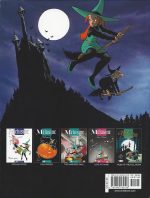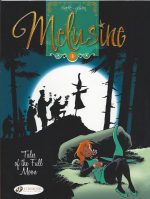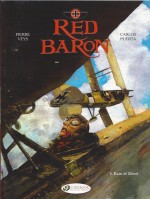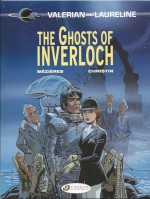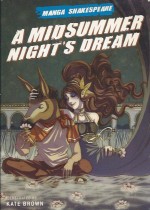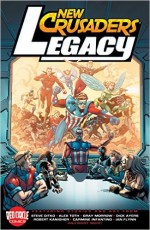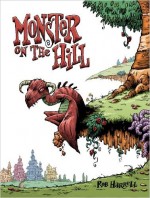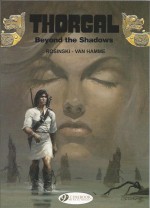
By George Herriman, edited by Bill Blackbeard (Fantagraphics Books)
ISBNs: 978-1-60699-316-3
I must admit to feeling like a fool and a fraud reviewing George Herriman’s winningly surreal masterpiece of eternal unrequited love. Although Krazy Kat is unquestionably a pinnacle of graphic innovation, a hugely influential body of work which shaped the early days of the comics industry and a paragon of world literature, some readers – from the strip’s earliest antecedents in 1913 right up to five minutes ago – just cannot “get itâ€.
All those with the right sequence of genes (“Kâ€, “Tâ€, “Z†and “Aâ€, but not, I suspect “Whyâ€) are lifelong fans within seconds of exposure whilst those sorry few oblivious to the strip’s inimitable charms are beyond anybody’s meagre capacity to help.
Still, since every day there’s newcomers to the wonderful world of comics I’ll assume my inelegant missionary position once more and hope to catch and convert some fresh souls – or, as today’s indisputable pictorial immortal might put it, save some more “lil Ainjilsâ€â€¦
Krazy Kat is not and never has been a strip for dull, slow or unimaginative people who simply won’t or can’t appreciate the complex multilayered verbal and pictorial whimsy, absurdist philosophy or seamless blending of sardonic slapstick with arcane joshing. It is the closest thing to pure poesy that narrative art has ever produced.
Think of it as a visual approximation of Dylan Thomas and Edward Lear playing “I Spy†with James Joyce amongst beautifully harsh and barren cactus fields whilst Gabriel GarcÃa Márquez types up the shorthand notes and keeps score…
George Herriman was already a successful cartoonist and journalist in 1913 when a cat and mouse who had been cropping up in the corners and backgrounds of his outrageous domestic comedy strip The Dingbat Family/The Family Upstairs finally graduated to their own feature.
Krazy Kat the strip debuted in William Randolph Hearst’s New York Evening Journal on October 28th 1913 and, mainly by dint of the publishing magnate’s overpowering direct influence, spread throughout his vast stable of papers.
Although Hearst and a host of the period’s artistic and literary intelligentsia (which included Frank Capra, e.e. Cummings, John Alden Carpenter, Gilbert Seldes, Willem de Kooning, H.L. Mencken and Jack Kerouac) utterly adored the strip, many local editors -ever-cautious of the opinions of the hoi-polloi who actually bought newspapers – did not, and took every career-threatening opportunity to eject it from the comics section.
Eventually the feature found a home in the Arts and Drama section of Hearst’s vast empire of periodicals. Protected by the publisher’s patronage, the strip flourished unharmed by editorial interference and fashion, running until Herriman’s death in April 1944.
The basic premise of the eccentric enterprise is simple: in an arid, anthropomorphic region of America bordering the mighty Rio Grande dwells Krazy; an effeminate, dreamy, sensitive and romantic feline of indeterminate gender, in uncompromising total love with rude, crude, brutal, mendacious and thoroughly scurrilous, married-with-children (so very many children) bad boy Ignatz Mouse.
Ignatz is a real Man’s Muridae; drinking, stealing, cheating, carousing, neglectful of his spouse and progeny. He revels in spurning Krazy’s genteel advances by regularly, repeatedly and obsessively belting the cat with a well-aimed and mightily thrown brick (obtained singly or in bulk, generally by legitimate purchase from noted local brickmaker Kolin Kelly).
The third member of the classic eternal triangle is lawman Offissa Bull Pupp, hopelessly in love with Krazy, well-aware of the Mouse’s true nature, but bound by his own timidity and sense of honour from removing his rival for the cat’s affections. Krazy is, of course, blithely oblivious of Pupp’s true feelings and dilemma…
Also populating the dusty environs are a stunning supporting cast of inspired anthropomorphic bit players such as Joe Stork, (deliverer of babies), the hobo Bum Bill Bee, larcenous Don Kiyoti, busybody Pauline Parrot, Walter Cephus Austridge, Chinese mallard Mock Duck, Joe Turtil and a host of other audacious characters – all capable of stealing the limelight and even supporting their own features.
The episodes occur in and around the Painted Desert environs of Coconino (based of the artist’s vacation retreat Coconino County, Arizona) and the surreal playfulness and fluid ambiguity of the flora and landscapes are perhaps the most important members of the cast.
These strips are a masterful mélange of wickedly barbed contemporary social satire, folksy yarn-telling, unique experimental art, strongly referencing Navajo art forms and sheer unbridled imagination and delightfully expressive language: alliterative, phonetically and even onomatopoeically joyous and compellingly musical (“He’s simpfilly wondafilâ€, “A fowl konspirissy – is it pussible?†or “I nevva seen such a great power to kookooâ€), yet for all that these adventures are timely, timeless, bittersweet, self-referential, fourth-wall bending, eerie, idiosyncratic and utterly hilarious escapades encompassing every aspect of humour from painfully punning shaggy dog stories to riotous silent-movie slapstick.
The Krazy & Ignatz series of collected Sunday pages was originally contrived by Eclipse Comics and the Turtle Island Foundation and taken over by Fantagraphics when the first publisher succumbed to predatory market conditions in the 1990s. Through diligence and sheer bloody determination matching Hearst’s own, the series was finally completed in 2015.
After years of scarily hand-to-mouth publishing, the entire Katty canon of magnificent Sunday pages has been collected in fabulous compilations and this first colour and monochrome volume opens with ‘And the First Shall Be the Last: A History of Kat Reprints’ and A Word from the Publisher by Kim Thompson delineating at length the eccentric orbit which finally resulted in Herriman’s masterpiece being collected in a complete, uniform, visually stunning 13 volume edition.
That’s followed by ‘The Kat’s Kreation’ from series Editor Bill Blackbeard; a fulsome, fascinating and heavily illustrated history tracing the development of the frankly freakish feline as briefly outlined above, and ‘Before He Went “Krazyâ€: George Herriman’s Aughts’, offering a liberal sampling of examples of the cartoonists many pre-Coconino strips and features such as ‘Lariat Pete’, ‘Bud Smith, the Boy Who Does Stunts’, ‘Rosy’s Mama’, ‘Zoo Zoo… (Goes Shopping, Entertains, And the Christmas Pie)’, ‘Alexander’ and ‘Daniel and Pansy’, spanning 1903 to 1909, with many sporting a certain prototype mad moggy in the corners…
From there it’s a short hop to the first cautious yet full-bodied escapades from 1916, delivered every seven days from April 23rd to December 31st.
Within that first year, as war raged in Europe and with America edging inexorably closer to the Global Armageddon, the residents of Coconino sported and wiled away their days in careless abandon but totally embroiled within their own – and their neighbours’ – personal dramas.
Big hearted Krazy adopts orphan kitties, accidentally goes boating and ballooning, saves baby birds from predatory mice and rats, survives pirate attacks, constantly endures assault and affectionate attempted murder and does lots of nothing in an utterly addictive, idyllic and eccentric way.
…And gets hit with bricks. Many, heavy and always evoking joyous, grateful raptures and transports of delight from the heart-sore hard-headed recipient…
In 1917 (specifically January 7th to December 30th), the eternal game played out as usual and with an infinite variety of twists, quirks and reversals. However there were also increasingly intriguing diversions to flesh out the picayune proceedings, such as recurring explorations of terrifying trees, grim ghosts and obnoxious Ouija Boards, tributes to Kipling as we discover why the snake rattles, meet Ignatz’s aquatic cousin, observe an invasion of Mexican Jumping Beans and a plague of measles, discover the maritime value of “glowermsâ€, learn who was behind a brilliant brick-stealing campaign of crime and at last see Krazy become the Bricker and not Brickee…
Fully in control of his medium, Herriman switched into poetic high gear as America finally entered the Great War in 1918.
With strips running from January 6th to December 29th, uncanny brick apparitions scotched somebody’s New Year’s resolutions, cantankerous automobiles began to disrupt the desert days, fun of a sort was had with boomerangs and moving picture mavens began haunting the region. There were deeply strange interactions with weather events, whilst music was made and occasional extended storylines began with the saga of an aberrant Kookoo Klock…
Surreal voyages were undertaken but over and again it was seen that there is literally no place like Krazy and Ignatz’s home. There was only one acknowledgement of Kaiser Bill and it was left to the missile-chucking mouse to deliver it…
And then it was Christmas and a new year and volume lay ahead…
To complete the illustrious experience and explore the ever-shifting sense of reality amidst the constant display of visual virtuosity and verbal verve this big, big book (305 x 230 mm and superbly designed by Chris Ware) ends with rare and informative bonus material such as ‘A Genius of the Comic Page’: a contemporaneous appreciation and loving deconstruction of the strip – with new illustrations from Herriman – by the astoundingly perspicacious and erudite critic Summerfield Baldwin taken from Cartoons Magazine and an oddly enigmatic biography of the reclusive creator in ‘George Herriman 1880-1944′ by Bill Blackbeard.
‘The Ignatz Mouse Debaffler Page’ then closes the show, providing pertinent facts, snippets of contextual history and necessary notes for the young and potentially perplexed…
Herriman’s epochal classic is a genuine Treasure of World Art and Literature. These strips shaped our industry, galvanised comics creators, inspired auteurs in fields as disparate as prose fiction, film, sculpture, dance, animation and jazz and musical theatre whilst always delivering delight and delectation to generations of devoted, wonder-starved fans.
If however, you are one of Them and not Us, or if you actually haven’t experienced the gleeful graphic assault on the sensorium, mental equilibrium and emotional lexicon carefully thrown together by Herriman from the dawn of the 20th century until the dog days of World War II, this glorious parade of cartoon masterpieces are your last chance to become a human before you die…
That was harsh, I know: not everybody gets it and some of them aren’t even stupid or soulless – they’re just unfortunate…
Still, There Is A Heppy Lend Furfur A-Waay if only you try to see…
© 2010 Fantagraphics Books. All rights reserved.
